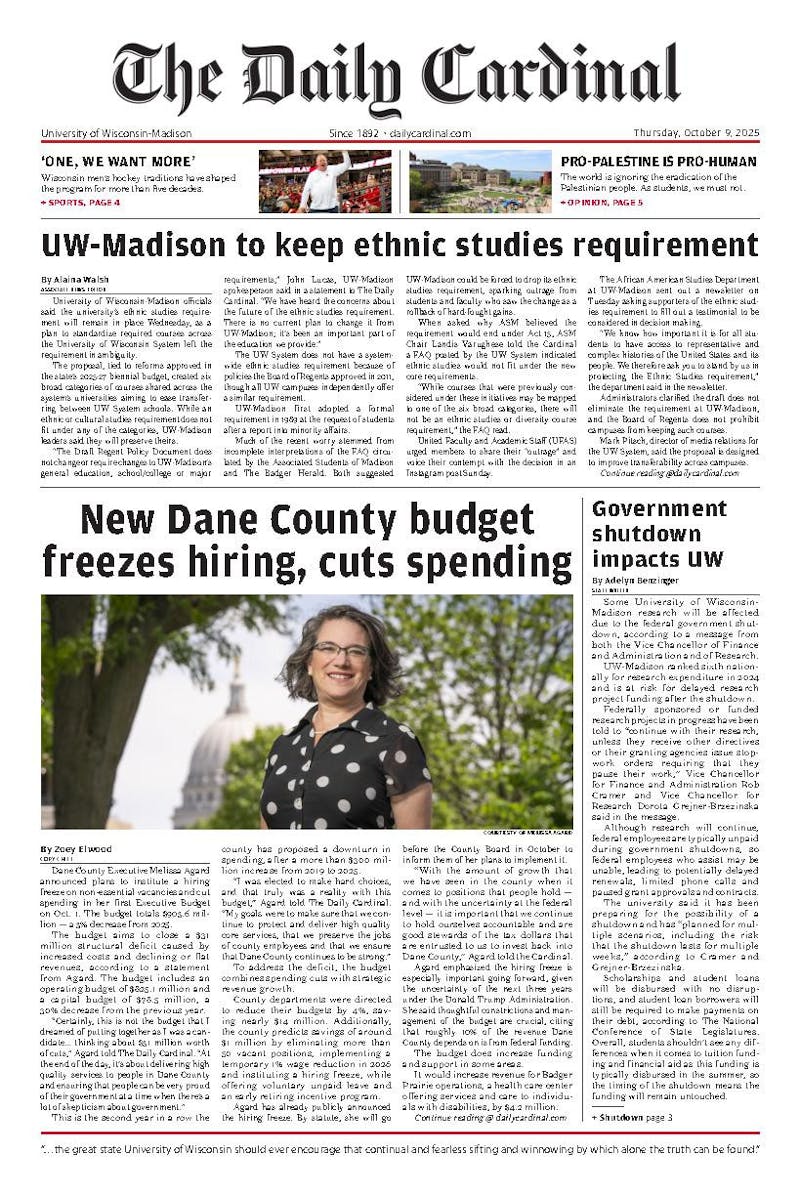It’s 8 a.m. and you're waiting for the 80 outside Dejope to take you to class. Boom. It's there on time. You're in class by 8:25 a.m., and all is as it should be. But come 10 a.m., 11 a.m., the bustling University of Wisconsin-Madison student body and our haphazard walking has disrupted our beloved buses entirely off their scheduled rhythm.
Outside of their glorious early morning consistency, the 80-line is a guessing game. You spin the wheel, and it can come up anywhere from one to 15 minutes: the difference between making it to discussion late or on time.
If you find yourself going from your dorm to class after 10 a.m., you don’t even consider taking the bus. Yet, somehow when one does, it’s still an overcrowded nightmare. It’s a minor inconvenience on a per-person basis. But for a school that houses half its student population 20 minutes from campus, a consistent public transportation system is the lifeblood of student learning.
The system is also built around the student-maligned, 10-minute bathroom breaks for the drivers at Memorial Union — a necessary inconvenience to keep our drivers sharp and safe on the road.
It’s been over a year since the last reported Badger Bus accident, and eight since one reported with a pedestrian. Yet throughout the day — as their bathroom breaks at the Memorial Union run long or short, or they're forced to stop and wait as hordes of students fill the streets around them and the bus itself — it creates stacks of buses all traveling as one.
It’s great if you’re there on time for the double buses. Then there’s no need to worry about being packed like a sardine into the bus — instead, you can feel like a nice Lays potato chip. But, on the unlucky days when you run up behind as the bus drives away, it's all terribly demoralizing, as you’re resigned to waiting 20-plus minutes for the next set of three to arrive.
As night comes, and the bus moves to hourly, consistency returns, but their utility falls all the more. If you get lucky, it's a nice little reward after a fun night at a friend's home or dorm. But most nights, it just leaves you to walk home through the raw Wisconsin wind and biting cold air.
All this can be fixed by more stringent scheduling, a higher volume of buses at peak times and the replacement of more stop signs with traffic lights.
Keeping all the buses on a truly steady schedule — through holding drivers accountable for their time stopped and increasing the variety in where they’re scheduled to stop — immediately alleviates the bus hordes that form at Memorial Union. The buses traverse almost everywhere on campus. Having some stop at Union South at coordinated times with those stopping at Memorial Union would instantly keep their rhythm more clock-like.
Increasing the bus volume from seven to 10 during peak hours and maintaining a steady group of three buses into nighttime would alleviate the majority of these problems. By pure volume, it would become almost impossible for a bus to not be right on the tail of the one you missed. Even when collected into hoards of two or three, and although not guaranteed, you could reasonably still expect a bus in no more than 10 minutes.
Now, as much as I’ve come for the bus system itself, we students also have some work to do.
In the almost streetlightless trip from Dejope to Linden and Charter, the haphazardly moving student body is almost impossible to predict. They cross the street at any odd chance — in many cases without regard for oncoming traffic and in turn their own life. No one wants their last words to be “I had the right of way.” But with the frivolity with which students dart across the street, it almost seems as if they may be.
At the bare minimum, containing them to lights would forcibly reduce our frankly ridiculous lack of vehicle consciousness and work to help maintain a consistent schedule for the buses. With enough properly placed lights, buses should never find themselves riding each other's tails.
Also, fellow students: the lack of on-bus etiquette is ridiculous. Not a single person moves their backpack down to the floor to make space for more people — even though it would easily allow 10 more students onto the bus.
Boarding and disembarking from the bus is even worse. No one waits with an ounce of courtesy for those clawing their way out of the bus to their stop. It’s a veritable zoo of college students clawing their way into and out of the masses.
As awful as we all are about bus etiquette, many of our issues would also be fixed with an increase in bus volume and a more rigid schedule. With more buses and fewer students per bus, there would be no need to claw and scratch your way on and off. So we all — hopefully — would simply stop doing so. But until then, I implore you to have some etiquette and thoughtfulness for others on your daily rides to and from class.
Wylie Dituri is a freshman staff writer and is currently undecided about his major. Do you think that the bus system in Madison has not reached its full potential? Send all comments to opinion@dailycardinal.com.





